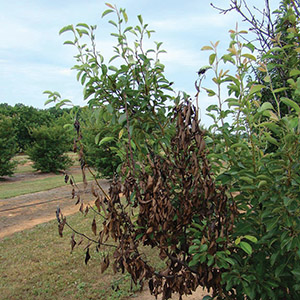Antibiotic-Resistant Fire Blight
 |
|
Fire blight in crab apple and apple. Rebekah D. Wallace, University of Georgia, Bugwood.org |
Fire blight, which is caused by the bacterial pathogen Erwinia amylovora, is a devastating disease of apples. The antibiotic streptomycin has remained the staple tool of fire blight prevention. Since 1972, streptomycin resistance of E. amylovora in apples has spread, making control of this disease even more difficult.
Several studies have shown that antibiotic use and misuse in both humans and animals poses a risk to the environment and potentially to human health (see Resources). Evidence suggests that the extensive use of antibiotics is a force in the emergence of resistant pathogenic microorganisms. In addition, the agricultural use of streptomycin could increase antibiotic resistance in our environment. However, the effects on human health of streptomycin resistance in plant pathogens such as E. amylovora have not been studied extensively in the United States.
Quen Zeng, a bacteriologist at the Connecticut Agricultural Experiment Satiation, studies plant diseases caused by bacteria. His current project, in collaboration with the Northeastern IPM Center, explores fire blight pathology and disease management.
Zeng is surveying streptomycin resistance in pathogen populations in New England to ascertain whether streptomycin remains an effective management tool. Early identification of diseased populations could help reduce the spread of resistant fire blight. Zeng’s short-term goal is to help growers with their needs and develop additional IPM techniques to control this disease. His long-term goal is to raise awareness of streptomycin resistance and promote IPM practices that can reduce the risk of inducing streptomycin resistance.
His work to date suggests that streptomycin remains an effective fire blight management option for the non-organic apple grower in New England. However, there is risk of the pathogens acquiring resistance. Zeng emphasizes the need to develop effective biological controls and other novel management strategies to supplement the use of antibiotics in fire blight management.
— by YIFEN LIU
The Northeastern IPM Center promotes integrated pest management for reducing risks to human health and the environment. If republishing our news, please acknowledge the source (“From Northeast IPM Insights”) along with a link to our website.
